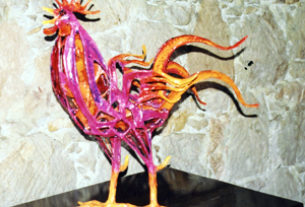Mexican Kitchen
For your free sample chapter – Click Here! .
Step into the Mexican Kitchen with Karen Hursh Graber, MexConnect’s monthly food columnist, for a look at the methods, materials, and ingredients that have characterized Mexico’s rich and varied dishes for hundreds of years. From pre-Hispanic times, through the Spanish colonial period, and up to the current, exciting era of nouvelle Mexican culinary innovations, this fascinating country has produced one of the world’s most creative, sophisticated and satisfying cuisines.
Prepare authentic Mexican specialties, presented with clear instructions and historical and cultural highlights, featured in the following sections:
- The Mexican Kitchen: Utensils and Techniques –
- What does it mean to “sweat” a chile? What kinds of salsas require roasting ingredients first, and how is it done? What utensils can be used in place of traditional Mexican cookware? These and many other frequently-asked questions are answered in a reader’s tour of the Mexican kitchen, which has changed surprisingly little since pre-Hispanic times. Recipes illustrating the use of techniques from dry-roasting to soft-frying are included, with a special emphasis on salsas, one of the cornerstones of Mexican cooking.
- Characteristic Ingredients: Herbs and Spices –
- A variety of Mexican herbs, spices and leaves, both fresh and dried, are explored in this section, which provides recipes for a variety of leaf-wrapped specialties, including tamales of different regions. A comprehensive source list for ordering dried ingredients, as well as seeds and plants, through the Internet and mail-order suppliers, is included.
- Characteristic Ingredients: Chiles –
- From fiery-hot habaneros to cherry-like cascabeles, the seemingly endless variety of Mexico’s chiles is a hallmark of its cooking. Over twenty-five kinds of chiles, fresh and dried, hot and mild, are presented, along with hints on handling chiles, and advice on combining different kinds of chiles with other ingredients. Recipes that add interest to vegetable and salad side dishes are included.
- Antojitos y Botanas: Appetizers and Snacks –
- Not only the “three T’s” (tacos, tostadas and tortas) but a variety of fare from elegant cocktail accompaniments to crowd-pleasing munchies are included. Surprise your family and friends with really authentic regional favorites, from the chalupas and tacos arabes of Puebla to the panuchos of the Yucatan.
- Sopa Aguada: Soups –
- No comida is considered complete in Mexico without a soup course. Hearty soups that are meals in themseves, elegant cremas and refreshing chilled soups are all included. Menu suggestions are given for incorporating soup courses as part of larger meals or as the main attraction of a lunch or light supper.
- Guisados: Stews –
- Probably the most frequently served everyday meal in Mexico, the guisado varies with the season, budget and region, but with the right combinations of ingredients, any guisado can be superb. Serve delicious combinations like Oaxacan Beef in Salsa Verde, Minted Chicken Stew with Vegetables, and Pork Loin in Peanut Sauce, just a few of the recipes offered in this section.
- Moles and Pipians –
- What’s the difference between a mole and a pipian? How is mole poblano different from mole negro? And what about green, yellow and red moles? The exotic combinations of herbs and spices, nuts and seeds, chiles and broths which make up these exquisite Mexican gourmet dishes are revealed here, in a comprehensive gathering of mole and pipian recipes.
- Sopa Seca: Rice and Pasta –
- Traditionally an indispensable part of the comida, the rice or pasta course has come into its own in recent years, with pasta being served as a main course in itself in many retaurants featuring nouvelle Mexican cuisine. A large selection of rice and pasta dishes combining pre-Hispanic and European ingredients is presented.
- Bebidas: Beverages –
- Recipes for many types of hot and cold Mexican beverages are given. Learn how to make fresh fruit drinks, traditional chocolate beverages, cafe de olla, atole, champurrada, and much more. A special section on Mexican cocktails and the history and traditions of making mescal, tequila, tepache and more.
- Pescados and Mariscos: Fish and Shellfish –
- On several trips to Mexico’s coastal resorts, fishing villages and palapa beaches, the author has gathered an extensive collection of seafood recipes from markets, restaurants, and fishermen. From grilling fresh fillets on the beach to preparing sophisticated company meals, these experiences and recipes are shared with the reader.
- Barbacoas y Parilladas: Barbecuing and Grilling, Mexican Style –
- Barbecuing and grilling are two very different cooking techniques in Mexico. This section explains the difference and teaches how to prepare succulent meat, poultry, fish and vegetable dishes using both techniques. Suggestions are given for adapting these techniques to the modern kitchen, or for taking them outdoors for memorable picnics and parties.
- Postres: Desserts –
- The national sweet tooth rarely goes unsatisfied, and this collection contains recipies for cakes and cookies, pies and candies. Learn how to prepare cochinitos, cuernos, and other types of pan dulce, along with flans, gelatins and more.
Bonus / Teaser!
As a way of introducing the The Mexican Kitchen: A Taste for all Seasons, Karen Hursh Graber has written a bonus chapter, apart from the twelve installments of the book that you will recieve. In answer to many questions about meal times and customs in Mexico, Karen has created a section on Las Comidas Diarias: Daily Meals in Mexico, with recipes for dishes served at the different meals.
Click here for this free bonus chapter.
![]()


